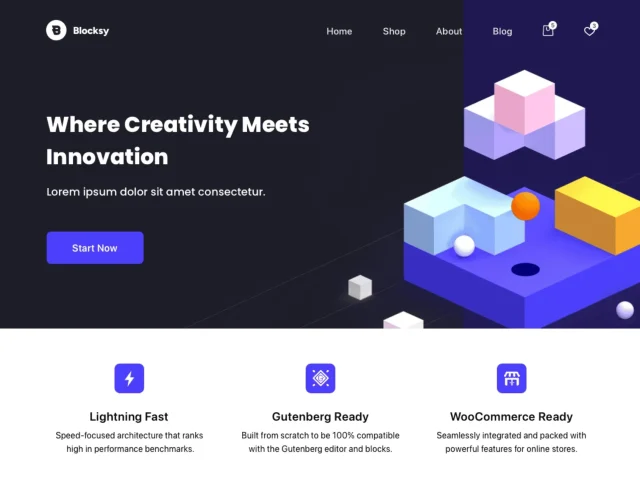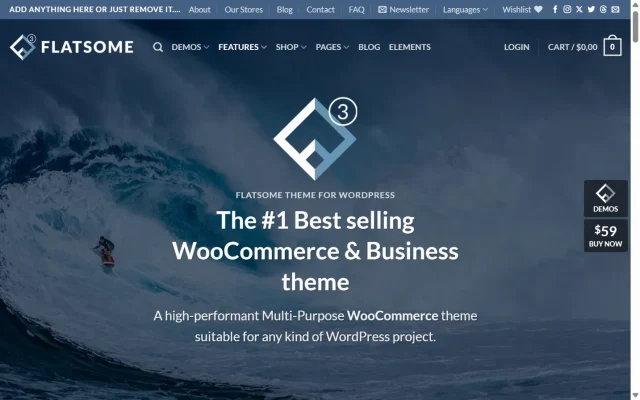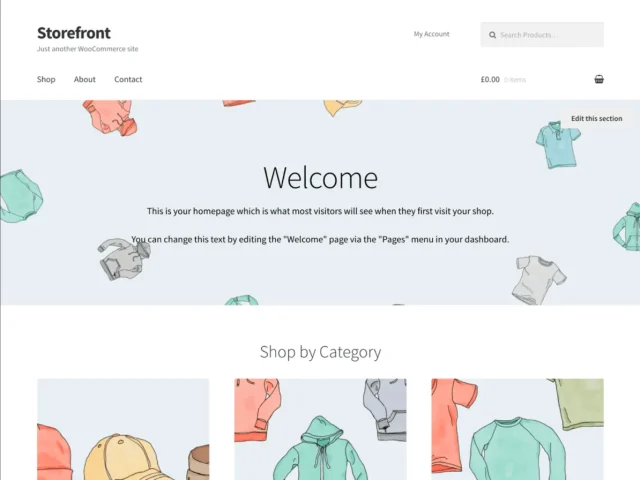Best eCommerce WordPress themes for online stores
Building an online store today isn’t just about listing your products and adding a cart button. It’s about creating an experience that feels fast, trustworthy, and tailored to your audience. Over the years, I’ve tested dozens of WordPress themes that promise to be “the best.” Some deliver beautifully; others, not so much.
In this post, I’ll walk you through what I genuinely consider the best eCommerce themes for WordPress right now, and more importantly, how to pick one that can grow alongside your business.
By the end of this post, you’ll know exactly which theme to pick for your store’s needs, what to watch out for, and how to make your eCommerce site shine both visually and technically.
Key takeaways
Section titled Key takeaways- Learn how to evaluate eCommerce themes using the same practical checklist I use – from speed and SEO to customization and reliability.
- Every theme featured here is fully WooCommerce-ready and optimized for mobile, performance, and user experience.
- Find out which tools to use to keep your site safe while testing or switching to a new theme.
- By the end, you’ll know exactly which eCommerce theme fits your store’s goals, style, and growth plans.
Methodology
Section titled MethodologyWhenever I write about WordPress themes, I like to go beyond what the marketing pages promise. I wanted to see how each theme actually performs once you start building a functional store and not just how it looks in the demo. Because let’s face it, almost every theme looks beautiful in its preview, but the real test begins when you add 50 products, a few plugins, and some customizations.
Here’s how I chose and judged the themes.
- WooCommerce compatibility & eCommerce-focus: The theme must integrate smoothly with WooCommerce and have store-specific features
- Performance & code-quality: Themes must be lightweight, well-coded, and not bloated
- Customization & future-proofing: Themes that support page builders or Gutenberg blocks, have good starter templates, and won’t become obsolete
- User feedback & updates: Themes that are actively maintained, well-reviewed, and used widely
After testing and comparing, I narrowed it down to 10 themes that offer the best balance of performance, usability, and design freedom. These are all perfect for developers, small business owners, and anyone serious about building a professional WordPress eCommerce store.
Switch themes safely
Running an online store means every minute matters. With UpdraftPlus Premium, you can back up automatically, clone or migrate your site in one click, and get 24/7 support, so you’re always protected against downtime or data loss.
Best eCommerce themes for WordPress
Section titled Best eCommerce themes for WordPressEvery theme you’ll find below has been evaluated based on practical standards and not just aesthetics. Whether you’re building your first online store or optimizing an existing one, these are the best eCommerce themes for WordPress that actually hold up in 2025 and beyond.
1. Astra
Section titled 1. AstraFree + Premium | Performance 9.8 | eCommerce Features 9.3 | Customization 9 | Support 9.5 | Overall 9.5/10
Ideal For: Anyone who values performance and scalability. Great for stores expecting to grow fast.

Astra remains one of my go-to themes for any online store. It’s lightweight, blazing fast, and integrates beautifully with WooCommerce and page builders like Elementor and Gutenberg. The free version is powerful, but the premium version adds advanced headers, mega menus, and prebuilt store templates.
Key features
- Lightweight, performance-focused theme (<50 KB base).
- Deep integration with WooCommerce (product grids, off-canvas filters, quick view).
- Huge library of starter templates (300+).
- Compatible with Elementor, Beaver Builder, Gutenberg blocks.
Pros
- Very strong on speed & performance.
- Free version is quite capable; premium adds advanced eCommerce features.
- Large community & documentation.
Cons
- Some key eCommerce features reserved for premium versions.
- Because it’s so flexible, you may spend time choosing settings.
Final verdict
If I were building or advising a store now, Astra would be high up on my shortlist among the best eCommerce themes for WordPress. Just make sure you pair with good hosting, caching, and backups and you’ll have a fast, reliable setup.
2. Shoptimizer
Section titled 2. ShoptimizerPremium | Performance 9.7 | eCommerce Features 9.5 | Customization 8.6 | Support 9.2 | Overall 9.3/10
Ideal For: Stores prioritizing speed and checkout optimization over heavy design.

As its name implies, Shoptimizer is built to help stores convert visitors into buyers. Developed by CommerceGurus, it’s optimized for checkout speed and UX. It’s one of my personal favorites for small businesses focused on conversion rates.
Key features
- Built specifically for WooCommerce stores, with the explicit goal of speed + conversions.
- Features like distraction-free checkout, trust badges, mega menu support, performance optimisation built in.
Pros
- Exceptional performance metrics claimed.
- Conversion-optimization features built in (checkout flow, trust elements).
Cons
- Premium only.
- Because of focus on conversion/speed, less emphasis on ultra-fancy layout design; you’ll still need good visuals.
Final verdict
If I were running a store where speed and conversions mattered more than flashy design, Shoptimizer would be near the top of my list.
3. Kadence
Section titled 3. KadenceFree + Premium | Performance 9.5 | eCommerce Features 9.2 | Customization 9.3 | Support 9 | Overall 9.2/10
Ideal For: Modern, minimalist eCommerce brands and course creators.

Kadence is one of the most balanced themes I’ve used—fast, flexible, and full of intuitive design controls. It’s particularly good for users who want drag-and-drop simplicity without bloat.
Key features
- Known for its speed and customization options; advanced header/footer builder; WooCommerce shop layouts.
- Compatible with popular page builders and built to scale.
Pros
- Strong both in performance and features.
- Developer-friendly and clean code.
- Good library of starter templates.
Cons
- To unlock full features you’ll likely need the pro version.
- Learning all of its advanced options takes time.
Final verdict
Kadence WP is a top pick if you want a performance-first foundation but still want layout/design flexibility. It’s highly recommended.
4. Blocksy
Section titled 4. BlocksyFree + Premium | Performance 9.3 | eCommerce Features 9 | Customization 9.4 | Support 8.8 | Overall 9.1/10
Ideal For: Developers and modern designers using the block editor.

Blocksy is future-ready, built for Gutenberg, and remarkably lightweight. It’s designed with a block-based architecture that fits where WordPress is headed in 2025 and beyond.
Key features
- Lightweight, modern theme built with Gutenberg blocks in mind; strong WooCommerce integration.
- Header & footer builder, conditional layouts, excellent performance.
Pros
- Very good performance.
- Free version is already strong.
- Built with modern WordPress features (blocks).
Cons
- Starter templates are fewer than some competitors.
- Ecommerce features are moderate in the free version; premium adds more.
Final verdict
If you care about modern design and solid performance, Blocksy consistently delivers. It’s perfect for developers and creators who like flexibility without sacrificing speed.
5. Neve
Section titled 5. NeveFree + Premium | Performance 9.6 | eCommerce Features 8.8 | Customization 9.1 | Support 8.5 | Overall 9/10
Ideal For: Modern stores that want lightning-fast performance and mobile-first design.

Neve is known for speed. Built by Themeisle, it’s fully AMP-optimized and loads extremely fast, even with WooCommerce active. Its modular setup means you only load the features you actually need.
Key features
- Modern, lightweight theme built for speed.
- Compatible with WooCommerce, Gutenberg, and major page builders.
- Starter templates aimed at stores.
Pros
- Good performance, modern architecture.
- Free version works for smaller shops.
Cons
- Fewer built-in advanced store features compared to dedicated eCommerce themes. You may need to add plugins.
Final verdict
Neve is a good choice for tech-savvy users who don’t need every out-of-the-box store feature and are comfortable extending functionality. It stands out for its speed and simplicity.
6. Botiga
Section titled 6. BotigaFree + Premium | Performance 9.2 | eCommerce Features 9.1 | Customization 8.7 | Support 8.9 | Overall 9/10
Ideal For: Entrepreneurs launching clean, conversion-optimized stores.

Botiga is sleek, modern, and tailored for conversions. Even its free version includes features like quick view, product filters, and multiple checkout layouts—something you rarely get for free.
Key features
- WooCommerce-specific theme designed for stores. Clean minimal design. Focus on speed & conversion.
- Works with block editor & Elementor. Good starter sites.
Pros
- Excellent performance (reviewers report very high scores).
- Free version available.
- Built for conversions.
Cons
- The free version has fewer advanced features compared to premium.
- Smaller ecosystem than some big players.
Final verdict
Botiga is a strong pick if you want something clean and conversion-focused, especially with speed in mind. A great fit for entrepreneurs who want a store that feels modern and effortless.
7. Flatsome
Section titled 7. FlatsomePremium | Performance 8.8 | eCommerce Features 9.5 | Customization 9 | Support 8.8 | Overall 9/10
Ideal For: Design-focused eCommerce sites, fashion brands, and portfolios with stores attached.

Flatsome is practically legendary among WooCommerce users. It’s beautiful, reliable, and tailored for stores that prioritize design. The live page builder is easy to use, and its library of pre-designed elements makes launching a polished site quick.
Key features
- Built specifically for WooCommerce stores: UX Builder, live search, quick view, wishlist.
- Large library of eCommerce-specific templates/demos (fashion, accessories, lifestyle).
- One-time purchase model typical on ThemeForest.
Pros
- Very good design & visual control.
- Rich built-in eCommerce features.
Cons
- Premium only (no strong free version).
- Heavier than minimal themes; performance depends on hosting + optimisation.
- Learning curve for the builder.
Final verdict
Flatsome earns its place among the best eCommerce themes when design and UX are key priorities. If speed is your top priority, you’ll want to optimize heavily.
8. Divi
Section titled 8. DiviPremium | Performance 8.2 | eCommerce Features 9 | Customization 9.8 | Support 8.9 | Overall 8.8/10
Ideal For: Creators and brands that want to build something truly unique.

Divi by Elegant Themes has its own visual builder, making it ideal for users who want complete creative freedom. While not as fast as Astra, it’s unmatched in design flexibility.
Key features
- Visual drag-and-drop builder built in; many eCommerce layouts included.
- Huge flexibility for design, layout, branding.
Pros
- Maximum design freedom.
- Large community, many layout packs.
Cons
- Premium only (no strong free version).
- Builder + theme can be heavier; you’ll need to optimise performance carefully.
- Potentially more time to build and maintain.
Final verdict
Divi is among the best eCommerce themes for WordPress if visual design and brand differentiation are your top objectives. If speed or budget are your top constraints, you might go with something lighter.
9. OceanWP
Section titled 9. OceanWPFree + Premium | Performance 8.5 | eCommerce Features 8.8 | Customization 9.2 | Support 8.2 | Overall 8.5/10
Ideal For: Developers or users who want fine-grained control over layout and design.

OceanWP is a classic multipurpose theme that shines when paired with WooCommerce. The free version includes essential shop templates and customisation controls, while the pro version adds advanced hooks, popups, and custom headers.
Key features
- Multipurpose theme with strong WooCommerce support (floating cart bar, quick view, filters).
- Good speed optimisation and responsive design.
- Works well with builders + Gutenberg.
Pros
- Free version is usable.
- Flexible and customisable.
Cons
- Because it’s multipurpose, it may not be as optimised purely for store performance as a dedicated eCommerce theme.
- Some advanced store features in premium add-ons.
Final verdict
OceanWP is a solid all-rounder. If your store is part of a broader site (or you anticipate expansions), it’s a solid choice for anyone looking to build a flexible eCommerce site that can grow over time.
10. Storefront
Section titled 10. StorefrontFree | Performance 8.8 | eCommerce Features 8 | Customization 7.5 | Support 8.5 | Overall 8/10
Ideal For: Developers and businesses that want a blank, stable foundation to customize.

Developed by WooCommerce’s own team, Storefront is minimal, stable, and designed specifically for the WooCommerce plugin. It’s not flashy, but it’s rock solid. If you prefer simplicity and reliability, this is a smart base.
Key features
- Developed by the WooCommerce team, so very well integrated.
- Minimalistic, highly compatible with WooCommerce and its extensions.
Pros
- Free and trusted.
- Solid compatibility with WooCommerce core and extensions.
Cons
- Basic design out of the box; fewer bells & whistles.
- To differentiate, you’ll likely need add-ons or customisation.
Final verdict
If I were advising someone building their first eCommerce store on a limited budget but with decent technical skills, I’d recommend using Storefront. Pair it with reliable hosting and regular backups, and you’ll have a solid foundation to grow from.
Manage all your WordPress stores in one dashboard
Running several eCommerce or client sites? With UpdraftCentral, you can control all your WordPress sites from one dashboard, schedule backups, update plugins and themes, and save hours of admin time.
Comparison table of the best eCommerce WordPress themes
Section titled Comparison table of the best eCommerce WordPress themesHow to make the most of your eCommerce site
Section titled How to make the most of your eCommerce siteChoosing the right theme is only half the story. What really makes your online store thrive is how you use it. Over the years, I’ve realized that many WordPress users pick a great-looking theme but never unlock its full potential. So here’s how you can make the most of your eCommerce setup.
1. Prioritize performance and speed
Section titled 1. Prioritize performance and speedYour theme should be lightweight and well-coded, but you can go a step further. Use a caching plugin, optimize your images, and consider a CDN for faster delivery. Remember – even a one-second delay can hurt conversions.
2. Keep design consistent with your brand
Section titled 2. Keep design consistent with your brandThe best stores have a clear visual identity. Customize your colors, typography, and layouts to reflect your brand. Don’t just stick with the default demo design. Small details like consistent button styles or accent colors make a big difference in perceived trust.
3. Optimize product pages for conversions
Section titled 3. Optimize product pages for conversionsYour product page is where decisions happen. Use high-quality images, short but persuasive descriptions, clear pricing, and visible “Add to Cart” buttons. If your theme supports quick views or sticky carts, use them.
4. Don’t ignore mobile users
Section titled 4. Don’t ignore mobile usersMore than half of online purchases happen on mobile. Choose a theme that’s not only “responsive” but designed for touch. Test your checkout experience on mobile regularly as long forms or small tap targets can easily hurt sales.
5. Track, test, and iterate
Section titled 5. Track, test, and iterateDon’t assume your store is “done.” Use analytics plugins, heatmaps, or A/B testing tools to see where people drop off. Sometimes, a tiny tweak like a simpler checkout button or fewer form fields can significantly boost your conversion rate.
By combining a great theme with these best practices, you’ll not only make your store look good but also perform like a high-converting sales engine.
Conclusion
Section titled ConclusionSelecting one of the the right themes for your ecommerce site early gives you an advantage, and not just in looks, but in performance, maintenance, scalability. You want something that helps you now, and plays nicely with what you’ll need later.
If I were to pick one recommendation: start with Astra, especially if you’re comfortable tweaking and want speed and flexibility, with a solid foundation that has proven to give great results. If your store is design-rich and you invest more, go for Flatsome. If you’re on budget and technical, Storefront is a safe start.
Choosing the right theme comes down to how you want customers to experience your store. But even the best design won’t matter if your site isn’t stable. Always take a backup before making changes, and remember, speed plays a huge role in how customers (and search engines) see your store too!
So go ahead. Explore, experiment, and build an online store that feels uniquely yours and make sure it’s fast, reliable, and ready for growth.
Speed up your eCommerce site in seconds
Slow sites lose sales. WP-Optimize Premium helps your eCommerce store run faster by cleaning, compressing, and caching your content for peak performance.
FAQs
Section titled FAQsWhich is the fastest eCommerce theme for WordPress in 2025?
Astra and GeneratePress remain the fastest eCommerce themes for WordPress. Both are lightweight, optimized for Core Web Vitals, and deliver excellent load times even with WooCommerce stores.
What is the best free eCommerce theme for WordPress?
Neve and OceanWP are among the best options. They offer WooCommerce compatibility, multiple demo layouts, and responsive design, ideal for startups or small businesses.
How do I choose the right eCommerce theme for WordPress?
Focus on speed, mobile responsiveness, SEO optimization, and WooCommerce integration. Also, ensure the theme is actively updated and compatible with your plugins.
What is the difference between a WooCommerce theme and a regular WordPress theme?
A WooCommerce theme includes built-in templates and styling for product grids, carts, and checkouts, while a regular theme might require manual adjustments for eCommerce features.
Which theme is best for fashion or lifestyle stores?
Flatsome, Blocksy and OceanWP are perfect for fashion stores as they come with stylish product galleries, lookbooks, and customizable product grids.
Should I use a free theme or go premium?
Start with a free WordPress theme to test compatibility, then upgrade to a premium option for advanced features like checkout optimization or custom headers.
How do I safely change my theme without losing data?
Always use a reliable backup plugin like UpdraftPlus before switching. It ensures you can restore your old design if needed.
Do these themes support multilingual stores?
Yes. Most premium WordPress themes now support WPML and Polylang, letting you create multilingual stores with ease.
About the author

Elvira Mishra
Elvira has over four years of experience creating and designing content in WordPress. Her background spans multiple digital disciplines, including marketing, SEO, user experience, and human computer interaction.
Categories
WP-Optimize
Get all our premium features. Lazy loading, pre-load key requests, Cloudfare integration. Optimize individual tables, delete unused images and more.
From just $49 for the year.
More stories
-

How to block a country in WordPress
Learn how to block a country in WordPress safely using AIOS, .htaccess rules, or CDN firewalls. Learn the best methods to protect your site without harming SEO.
-

Best spam protection plugins for WordPress
This guide compares the best WordPress spam protection plugins to help you block bots, protect discussions, and keep your site clean.
-

Best CAPTCHA plugins for WordPress
Learn why a WordPress captcha plugin is essential for protecting your site from unwanted spam and malicious activity.
-

How to make your WordPress site accessible
Learn how to make your WordPress site accessible with simple steps that improve usability, meet WCAG guidelines, and boost SEO.
